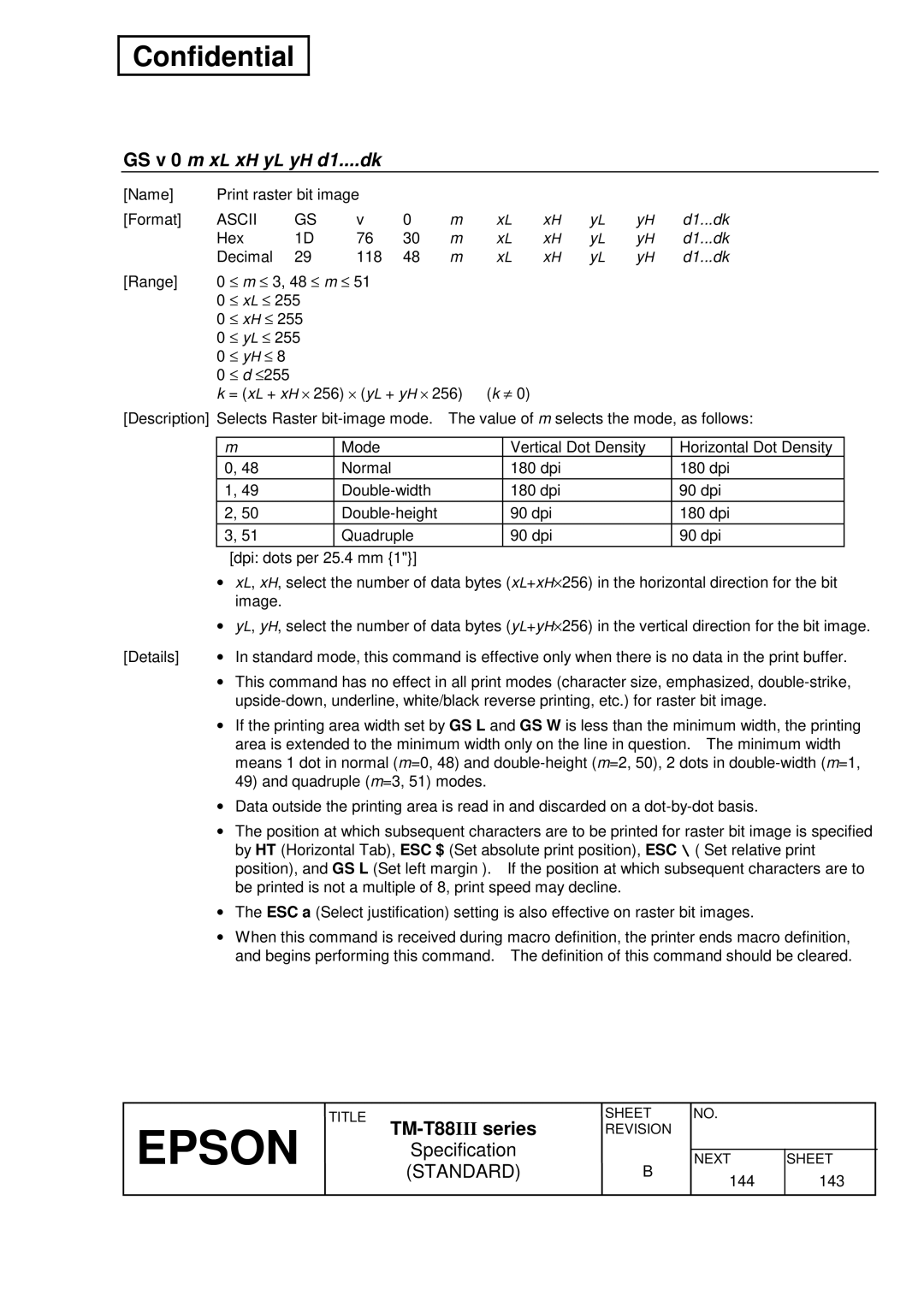
Confidential
GS v 0 m xL xH yL yH d1....dk
[Name] | Print raster bit image |
|
|
|
|
|
|
| |||
[Format] | ASCII | GS | v | 0 | m | xL | xH | yL | yH | d1...dk | |
| Hex | 1D | 76 | 30 | m | xL | xH | yL | yH | d1...dk | |
| Decimal | 29 | 118 | 48 | m | xL | xH | yL | yH | d1...dk | |
[Range] | 0 ≤ | m ≤ 3, 48 ≤ m ≤ | 51 |
|
|
|
|
|
|
| |
| 0 ≤ | xL ≤ | 255 |
|
|
|
|
|
|
|
|
| 0 ≤ | xH ≤ | 255 |
|
|
|
|
|
|
|
|
| 0 ≤ | yL ≤ | 255 |
|
|
|
|
|
|
|
|
| 0 ≤ | yH ≤ | 8 |
|
|
|
|
|
|
|
|
| 0 ≤ | d ≤ 255 |
|
|
|
|
|
|
|
| |
| k = (xL + xH ⋅ 256) ⋅ | (yL + yH ⋅ | 256) | (k ≠ | 0) |
|
|
| |||
[Description] Selects Raster
m | Mode | Vertical Dot Density | Horizontal Dot Density |
0, 48 | Normal | 180 dpi | 180 dpi |
1, 49 | 180 dpi | 90 dpi | |
2, 50 | 90 dpi | 180 dpi | |
3, 51 | Quadruple | 90 dpi | 90 dpi |
[dpi: dots per 25.4 mm {1"}]
•xL, xH, select the number of data bytes (xL+xH⋅ 256) in the horizontal direction for the bit image.
•yL, yH, select the number of data bytes (yL+yH⋅ 256) in the vertical direction for the bit image.
[Details] | • In standard mode, this command is effective only when there is no data in the print buffer. |
| • This command has no effect in all print modes (character size, emphasized, |
| |
| • If the printing area width set by GS L and GS W is less than the minimum width, the printing |
| area is extended to the minimum width only on the line in question. The minimum width |
| means 1 dot in normal (m=0, 48) and |
| 49) and quadruple (m=3, 51) modes. |
| • Data outside the printing area is read in and discarded on a |
| • The position at which subsequent characters are to be printed for raster bit image is specified |
| by HT (Horizontal Tab), ESC $ (Set absolute print position), ESC \ ( Set relative print |
| position), and GS L (Set left margin ). If the position at which subsequent characters are to |
| be printed is not a multiple of 8, print speed may decline. |
| • The ESC a (Select justification) setting is also effective on raster bit images. |
| • When this command is received during macro definition, the printer ends macro definition, |
| and begins performing this command. The definition of this command should be cleared. |
EPSON | TITLE |
| SHEET | NO. |
|
| REVISION |
|
| ||
| Specification |
|
|
| |
|
| NEXT | SHEET | ||
| (STANDARD) | B | |||
|
|
|
| 144 | 143 |
